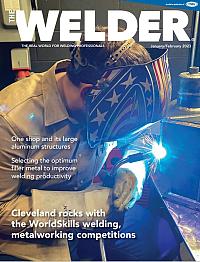Technical Liaison Manager
- FMA
- The Fabricator
- FABTECH
- Canadian Metalworking
Categories
- Additive Manufacturing
- Aluminum Welding
- Arc Welding
- Assembly and Joining
- Automation and Robotics
- Bending and Forming
- Consumables
- Cutting and Weld Prep
- Electric Vehicles
- En Español
- Finishing
- Hydroforming
- Laser Cutting
- Laser Welding
- Machining
- Manufacturing Software
- Materials Handling
- Metals/Materials
- Oxyfuel Cutting
- Plasma Cutting
- Power Tools
- Punching and Other Holemaking
- Roll Forming
- Safety
- Sawing
- Shearing
- Shop Management
- Testing and Measuring
- Tube and Pipe Fabrication
- Tube and Pipe Production
- Waterjet Cutting
Industry Directory
Webcasts
Podcasts
FAB 40
Advertise
Subscribe
Account Login
Search
Diagnosing porosity issues in vertical-up gas metal arc welding-pulse (GMAW-P)
- By David Meyer and Rob Koltz
- January 20, 2023
- Article
- Consumables
Our shop recently added gas metal arc welding-pulse (GMAW-P) capabilities using solid wire and a 92% argon/8% CO2 gas blend. Historically, we have used CO2 gas-shielded flux-cored products for all our carbon steel manual welding, but deposition efficiency improvements and fume level reduction prompted the change. The welders struggle with porosity issues when using GMAW-P in vertical-up welds. This happens typically in deeper groove welds where access to the root can sometimes be a challenge. Any ideas?
To start, let's define what welding porosity is.
Porosity occurs when nitrogen, hydrogen, or oxygen become trapped in the solidifying weld metal as small gas bubbles. The sources of these three elements are atmospheric air, moisture, or the burning of hydrocarbons such as grease and oil. The welding arc is extremely hot, which causes these molecules to separate into their respective elements: hydrogen, nitrogen, carbon, and/or oxygen. These elements can reach levels beyond what filler metal deoxidizers can remove from the molten weld puddle and become trapped, resulting in porosity.
We are missing a little bit of information such as welding parameters, wire diameter and type, and any details about the base material. Occasionally, something minor in the details will jump out as the cause.
To minimize the potential for porosity, follow these basic good welding practices:
- Make sure the weld joint is free and clean of contaminants such as moisture, grease, paint, dirt, rust, and excessive mill scale.
- Ensure the welding zone is protected from excessive air currents such as open doors and fans.
- Ensure proper shielding gas and flow rates.
- Make sure there are no shielding gas leaks in welding gun or supply hoses/lines.
- Use proper welding techniques (i.e., avoid excessive electrical stick-out (ESO) or depositing extremely large weld beads).
- Minimize nozzle dip use.
- Use premium filler metals and do not use the red wool wire pads.
With the information you provided, let's examine what may be causing the porosity. Assuming the weld joint is clean and you follow good welding practices, then it may be something a little more subtle.
Gas-shielded flux-cored wires are resilient when dealing with less-than-perfect weld conditions. The weld protection they provide with the slag layer and external shielding gas make them very robust for many applications. Because of these features, your welders most likely experience few issues with them.
Comparatively, solid wires do not offer the same benefits. They lack the slag layer, which can provide additional weld metal protection when you lose shielding gas or the additional deoxidizers. Additionally, CO2 shielding gas provides great cleaning action on contaminants such as rust and mill scale. The solid-wire shielding gas you're using contains mostly argon—which is nonreactive—and a small amount of CO2 compared to the flux-cored wire, which reduces the cleaning action.
You stated the main porosity areas are hard-to-reach, vertical-up groove weld joints. This brings proper shielding gas coverage into consideration. If the joints are difficult to reach, it is possible your ESO is excessive, which can lead to a lack of shielding gas protection. If you are using standard 5/8-in. weld gun nozzles, this will force the welder to use an excessive ESO to see and access the joint.
However, if you are using 3/8-in. tapered gas nozzles, you will want to verify shielding gas flow rate at the nozzle.
The general recommendation for non-helium shielding gas flow rates is 25 to 35 cubic feet per hour (CFH) for small-diameter wires and 35 to 45 CFH for large-diameter wires with standard nozzles. If you are using the 3/8-in. tapered nozzles, you will want to set the flow rate no higher than 30 CFH. The reason is for a set volume of gas to exit the nozzle, it will have an associated velocity. As you increase flow rate, the velocity increases as well. When you increase flow rates above 45 CFH in standard nozzles, the exiting gas velocity creates a vacuum near the end of the nozzle opening, which may aspirate atmospheric air into the shielding gas plume. The exiting shielding gas velocity in tapered nozzles may become excessive at much lower flow rates, which can produce the same issues. Not only can this produce porosity, it is simply a waste of shielding gas.
About the Authors


Rob Koltz
Application Engineer
411 S. Ebenezer Rd.
Florence, 29501
636-485-2253
About the Publication
Related Companies
subscribe now

The Welder, formerly known as Practical Welding Today, is a showcase of the real people who make the products we use and work with every day. This magazine has served the welding community in North America well for more than 20 years.
start your free subscription- Stay connected from anywhere

Easily access valuable industry resources now with full access to the digital edition of The Fabricator.

Easily access valuable industry resources now with full access to the digital edition of The Welder.

Easily access valuable industry resources now with full access to the digital edition of The Tube and Pipe Journal.
- Podcasting
- Podcast:
- The Fabricator Podcast
- Published:
- 04/16/2024
- Running Time:
- 63:29
In this episode of The Fabricator Podcast, Caleb Chamberlain, co-founder and CEO of OSH Cut, discusses his company’s...
- Trending Articles
Sheffield Forgemasters makes global leap in welding technology

ESAB unveils Texas facility renovation

Engine-driven welding machines include integrated air compressors

How welders can stay safe during grinding

The impact of sine and square waves in aluminum AC welding, Part I

- Industry Events
16th Annual Safety Conference
- April 30 - May 1, 2024
- Elgin,
Pipe and Tube Conference
- May 21 - 22, 2024
- Omaha, NE
World-Class Roll Forming Workshop
- June 5 - 6, 2024
- Louisville, KY
Advanced Laser Application Workshop
- June 25 - 27, 2024
- Novi, MI




























